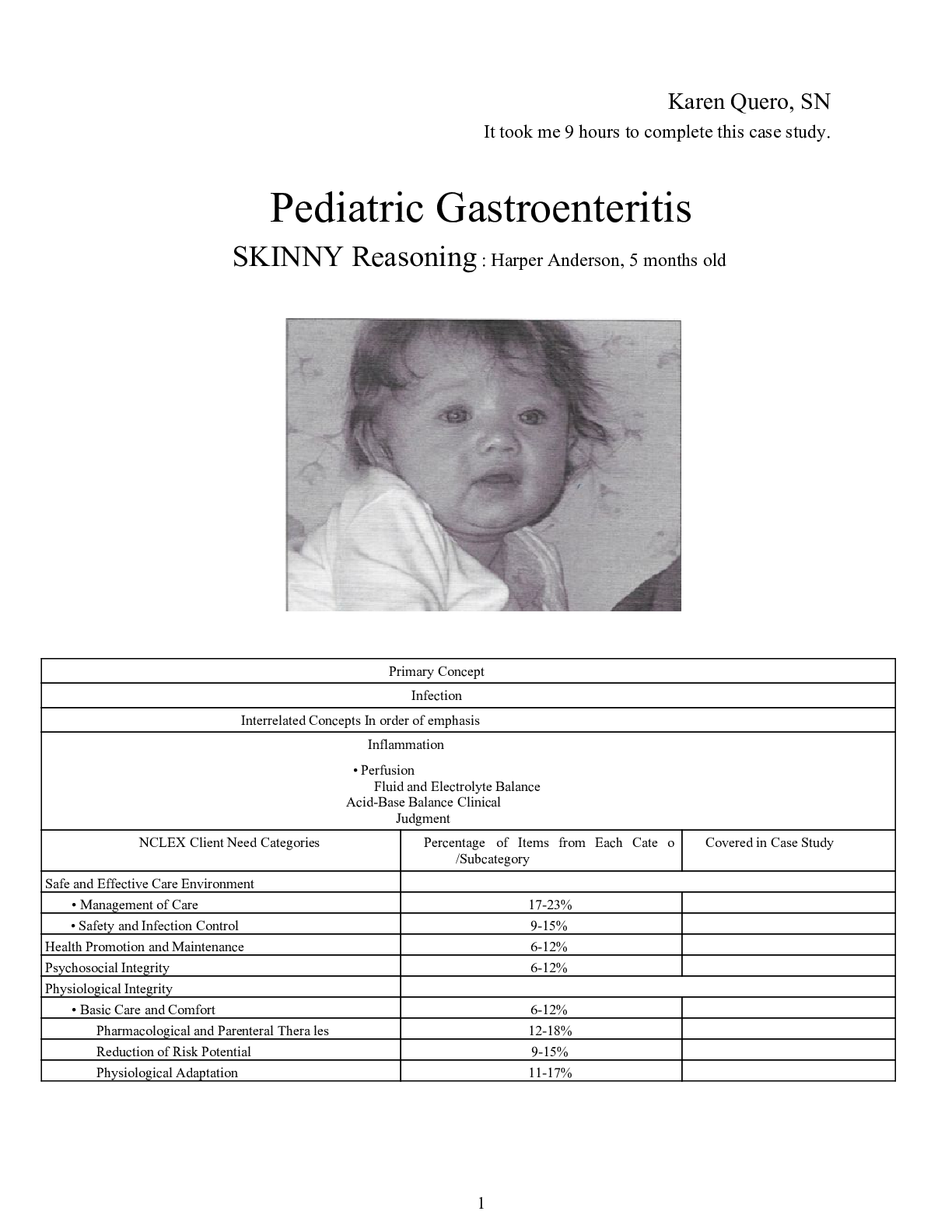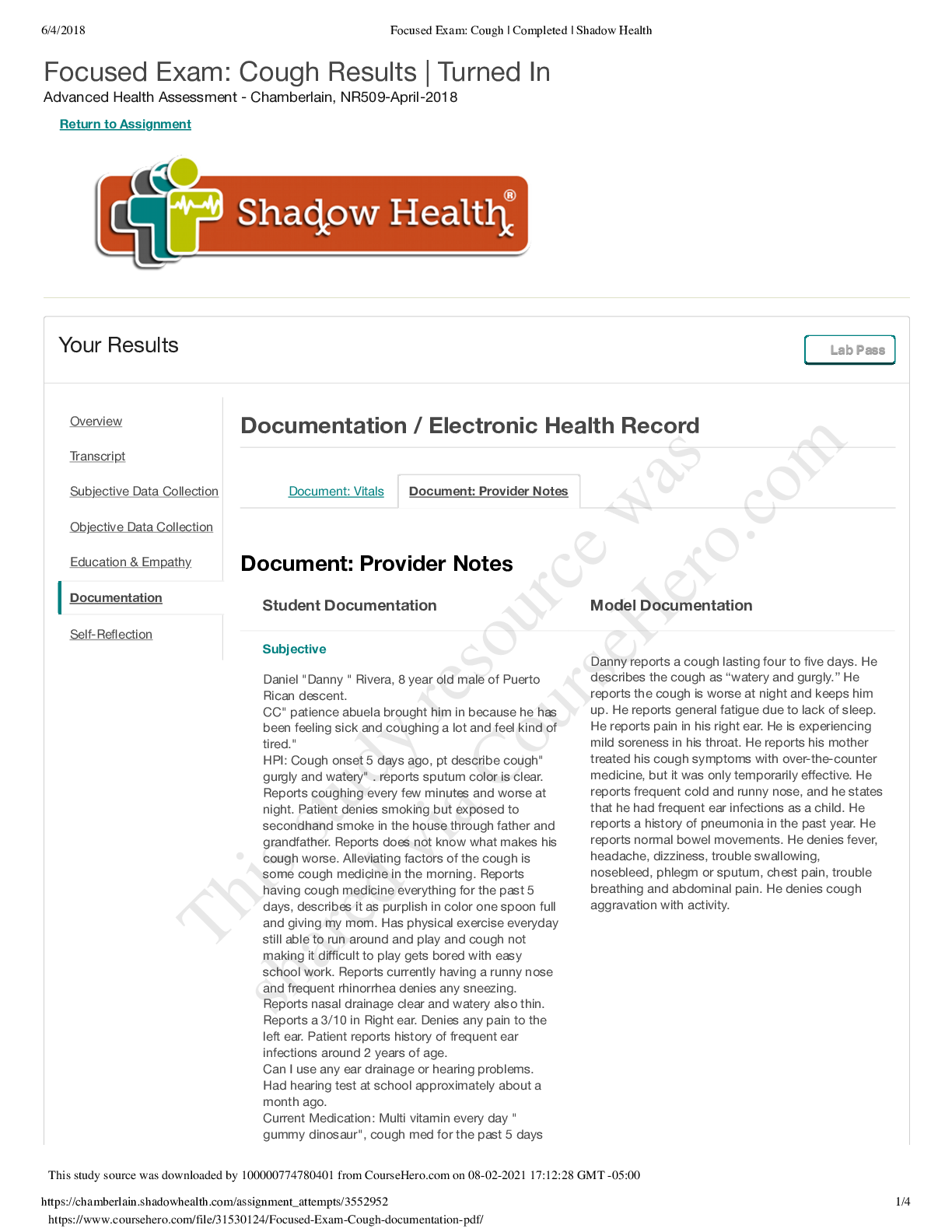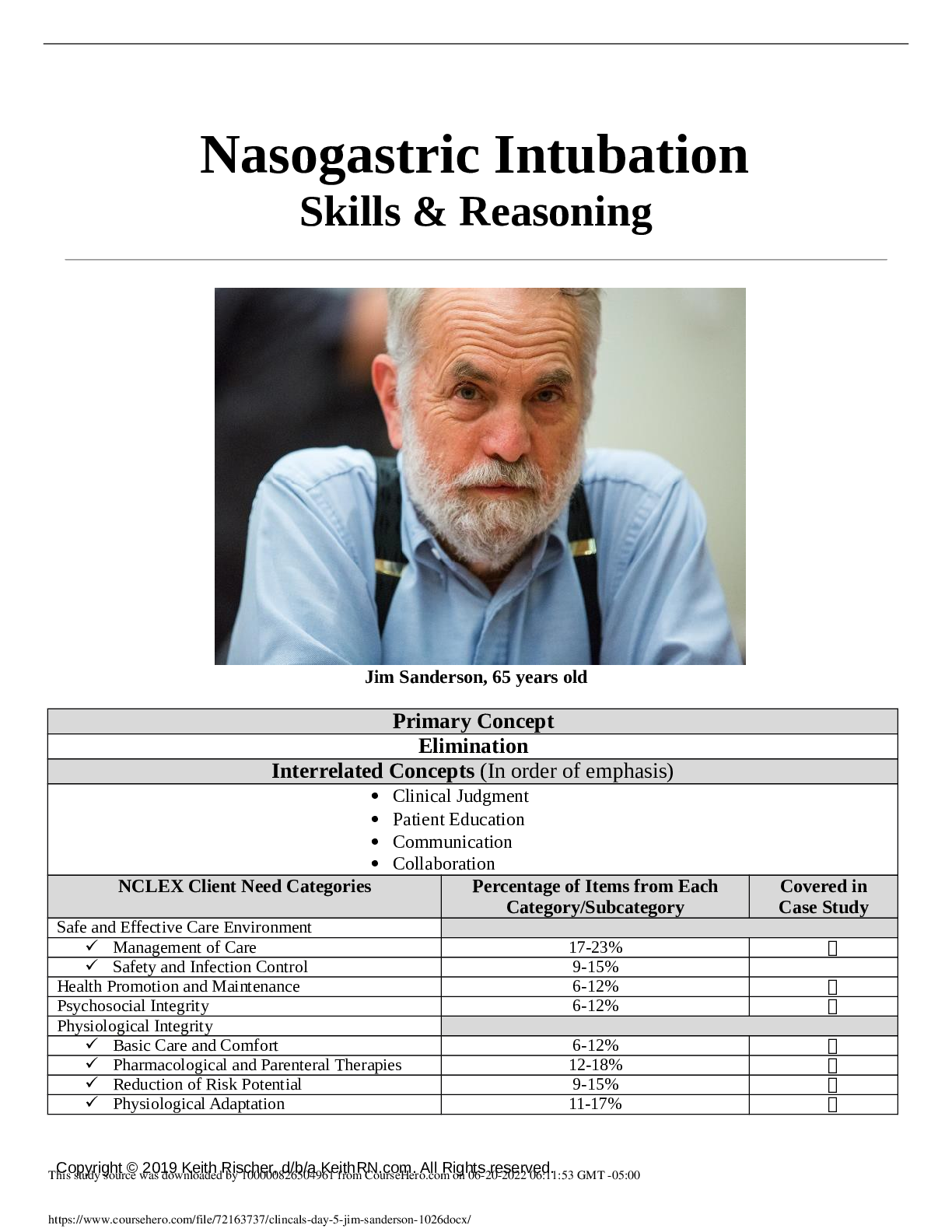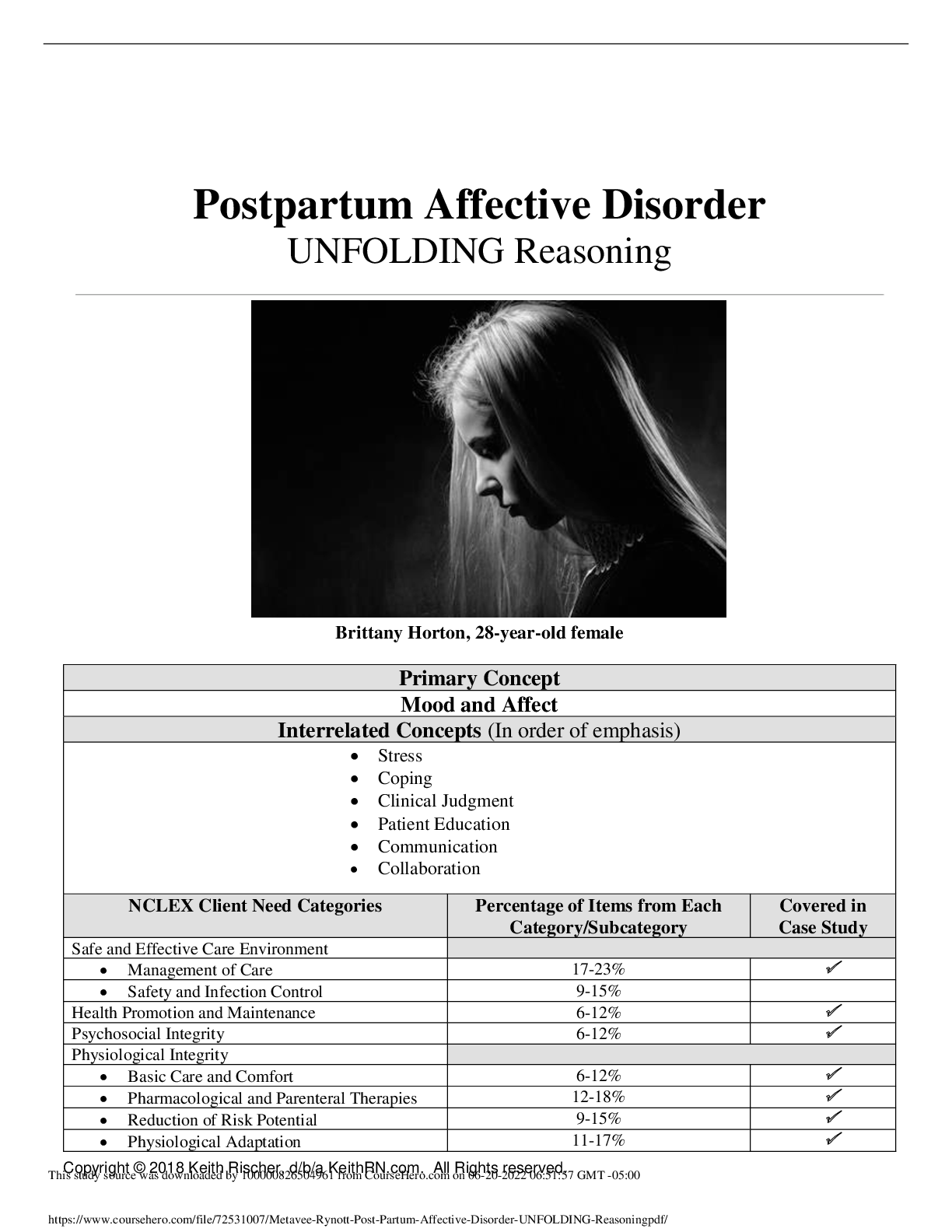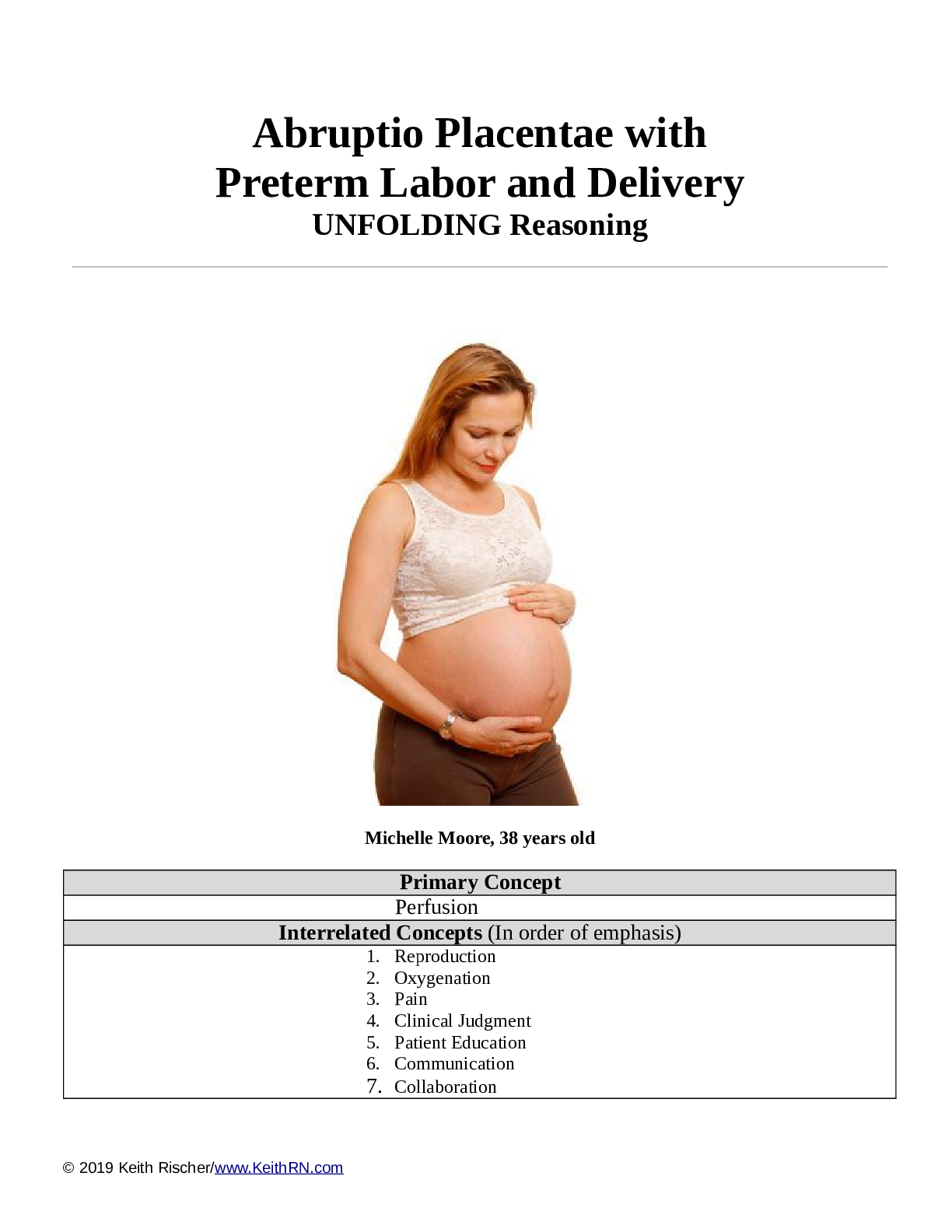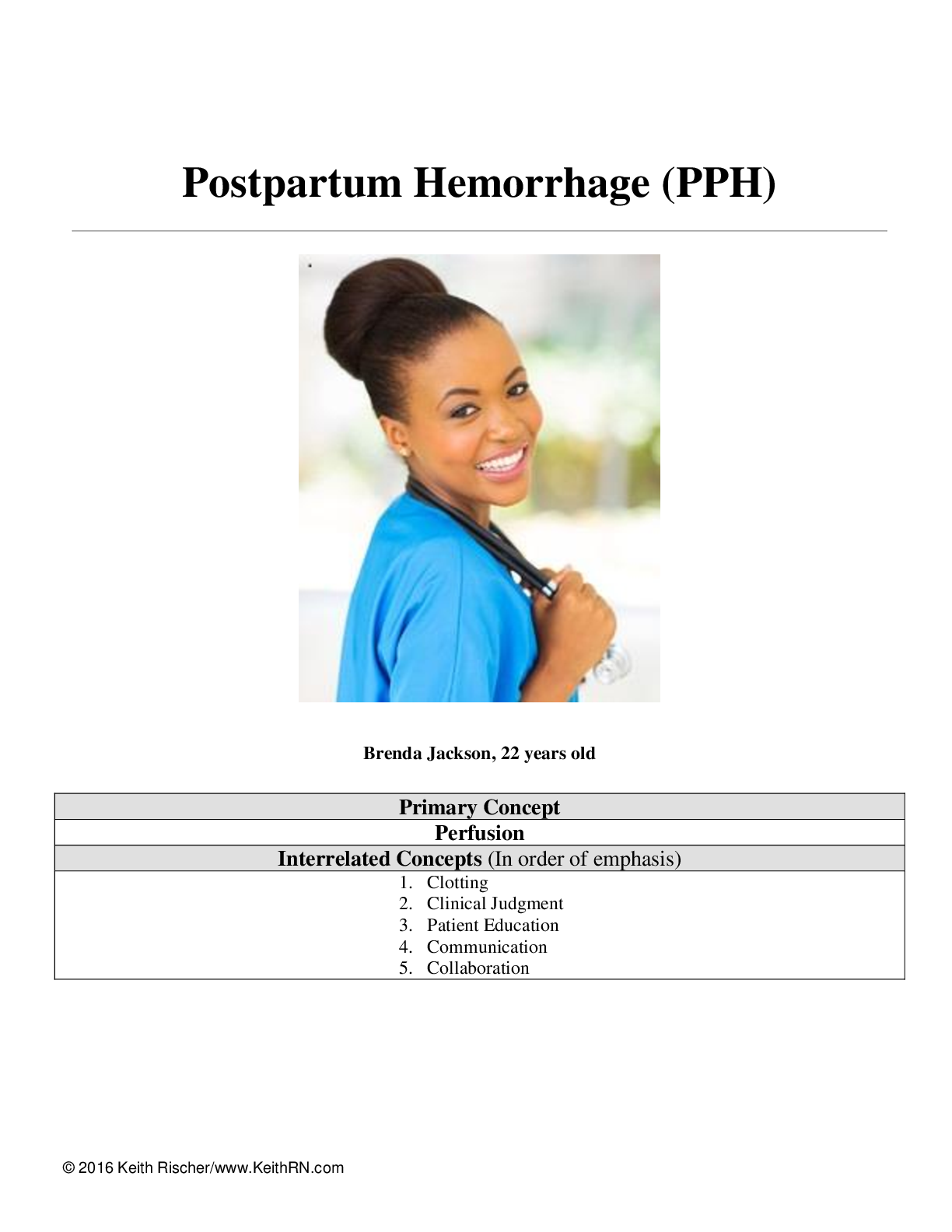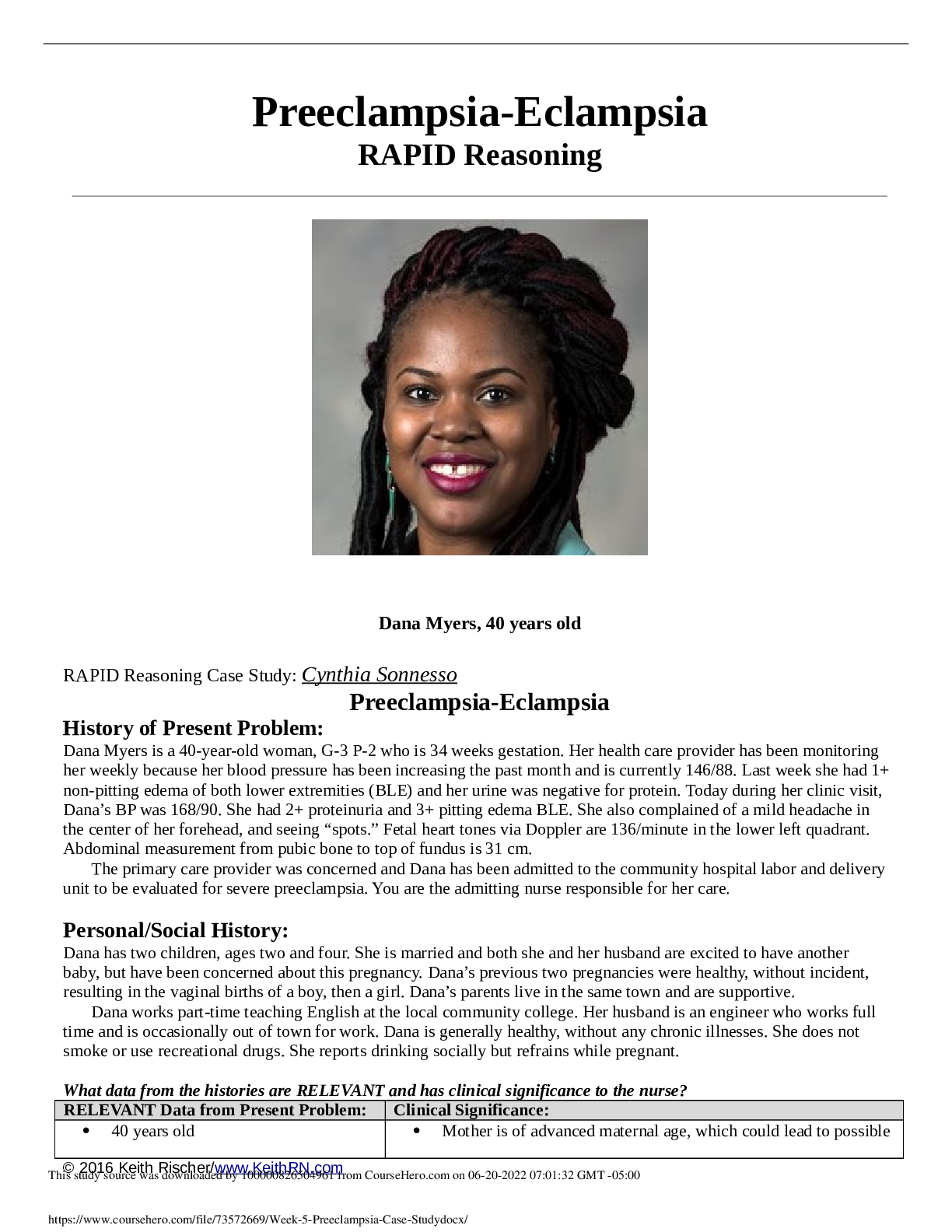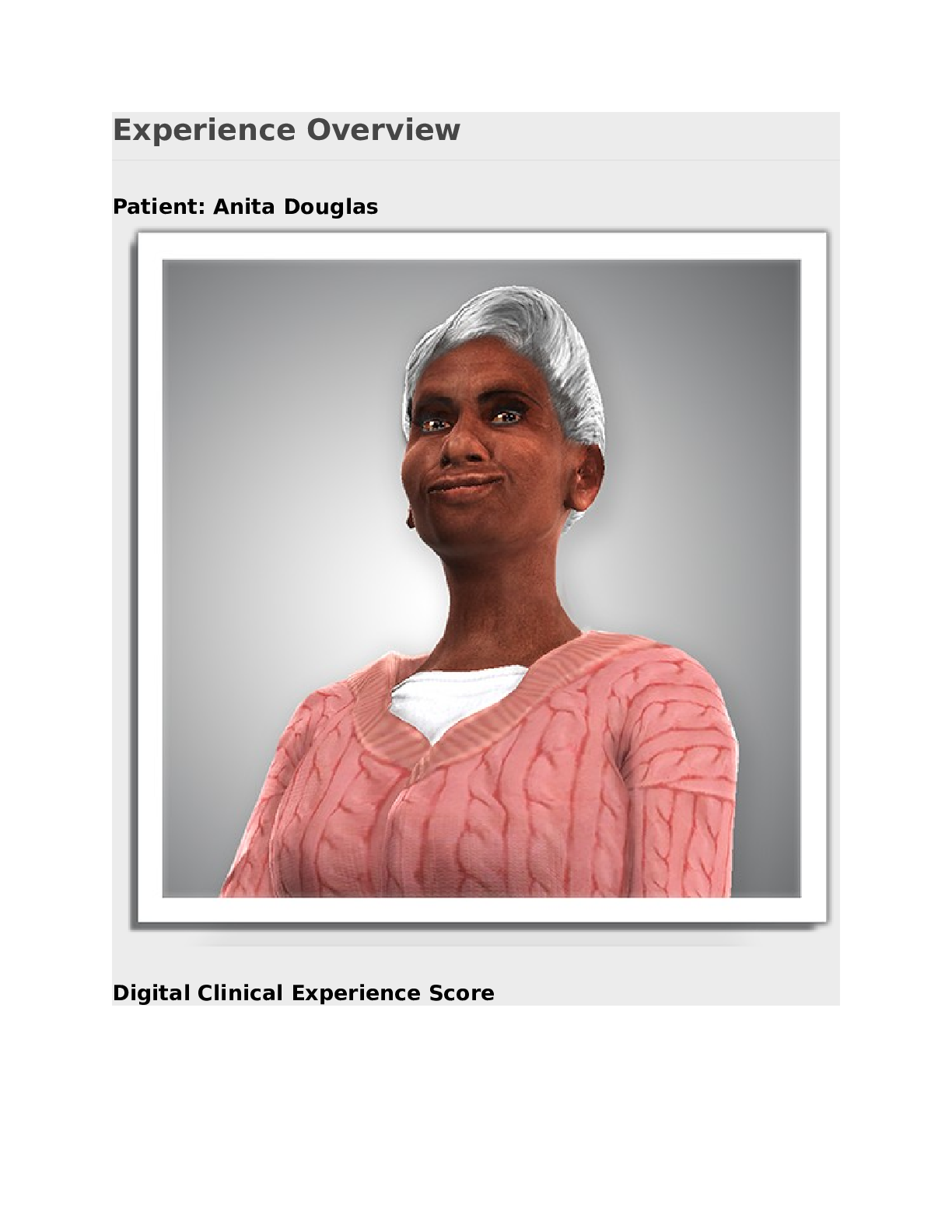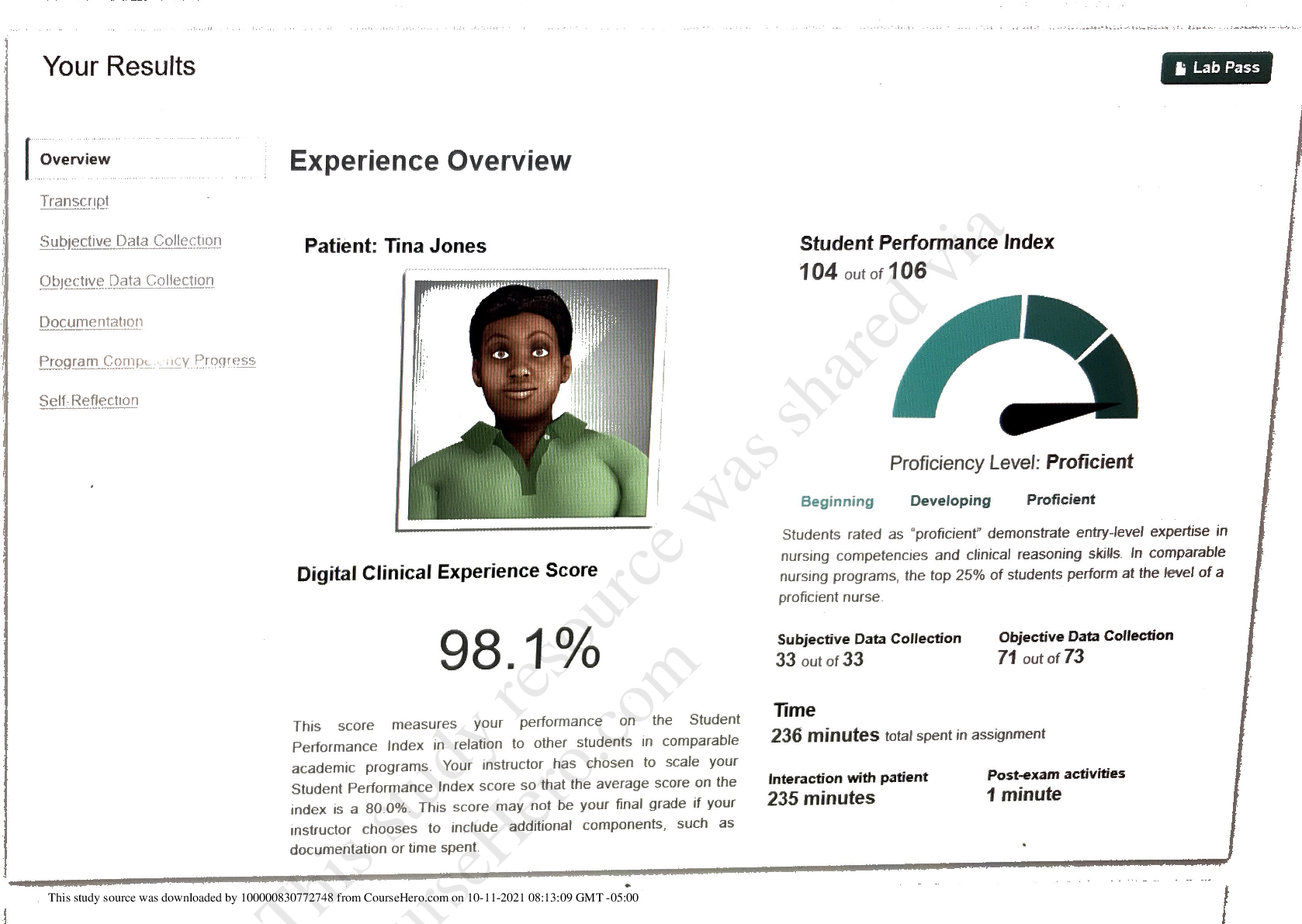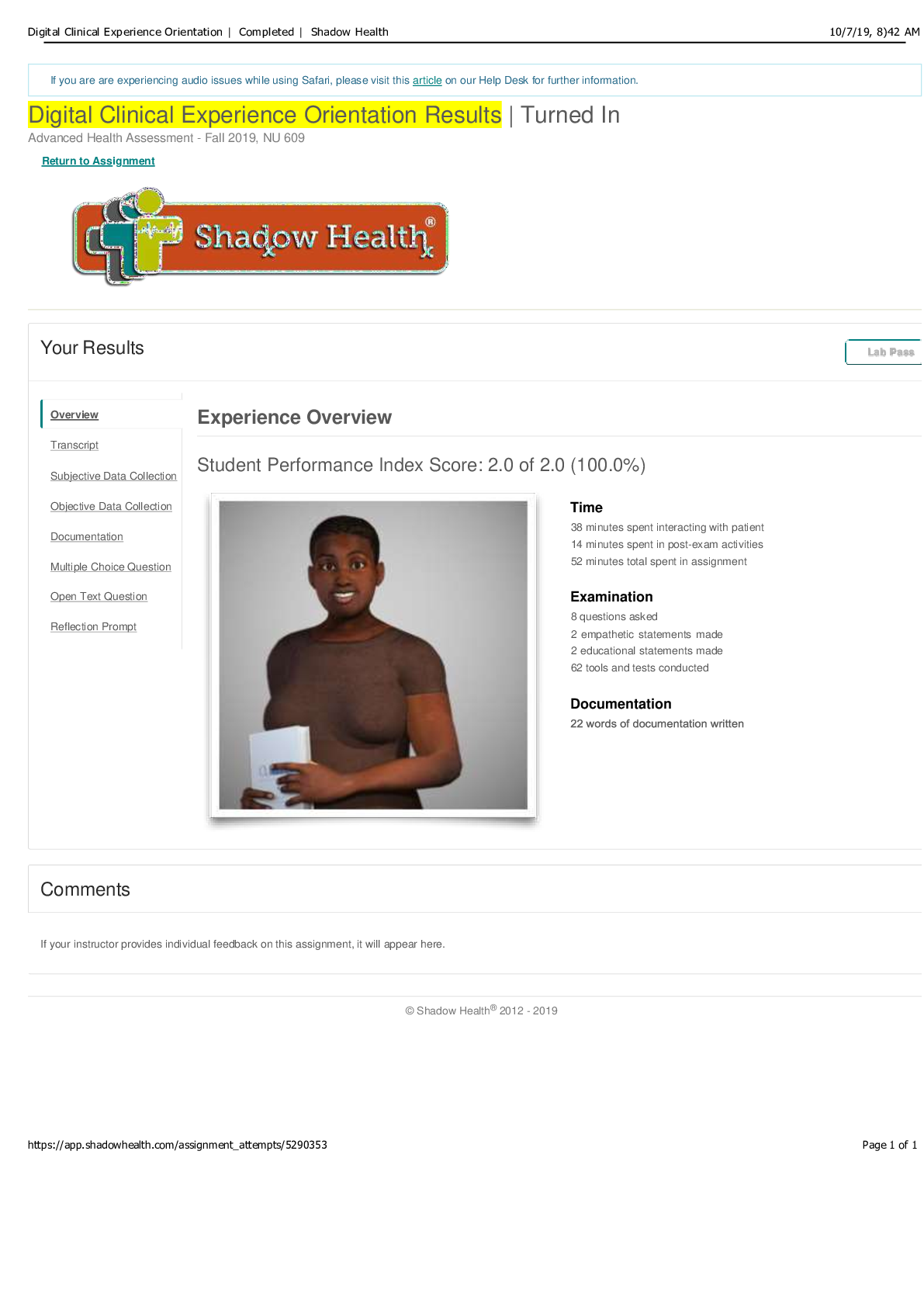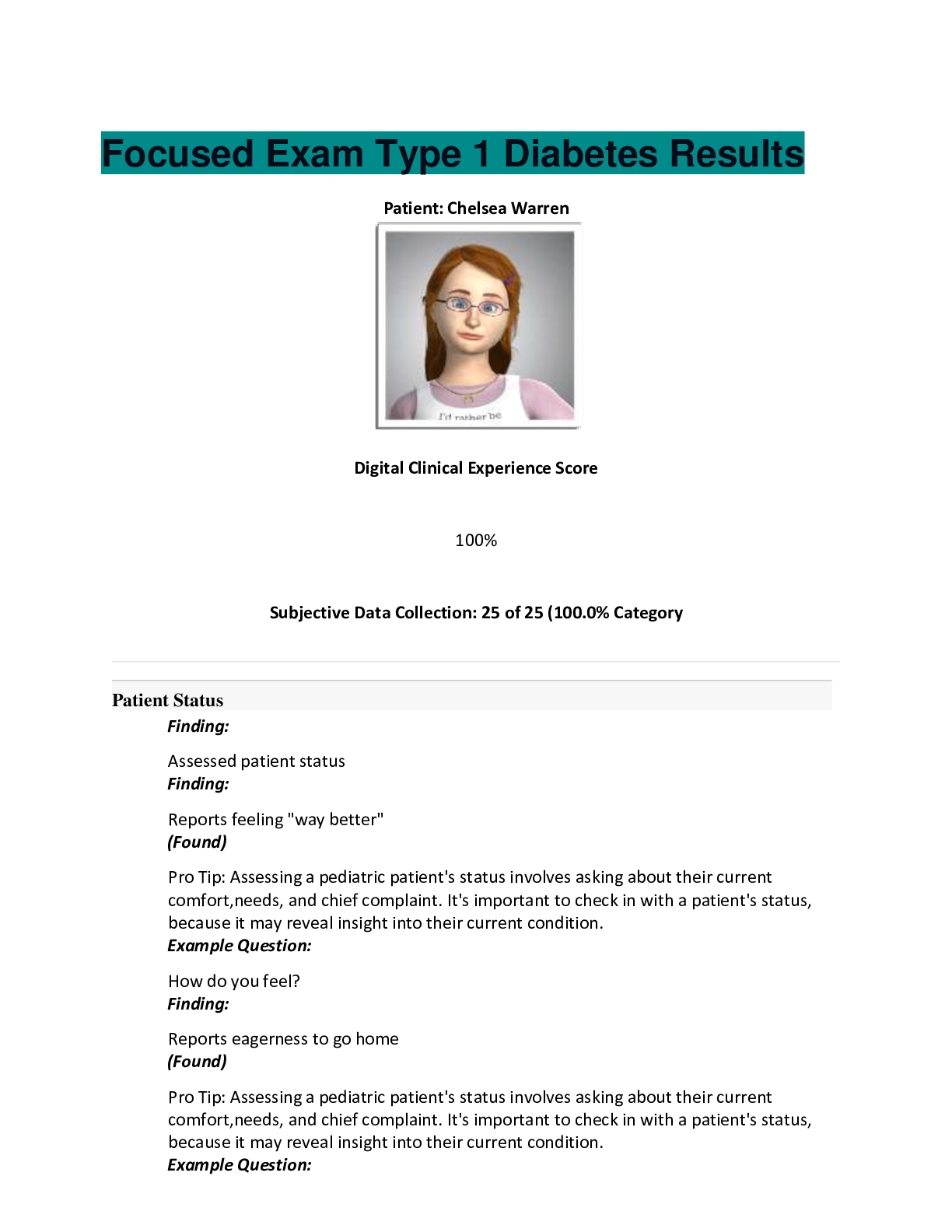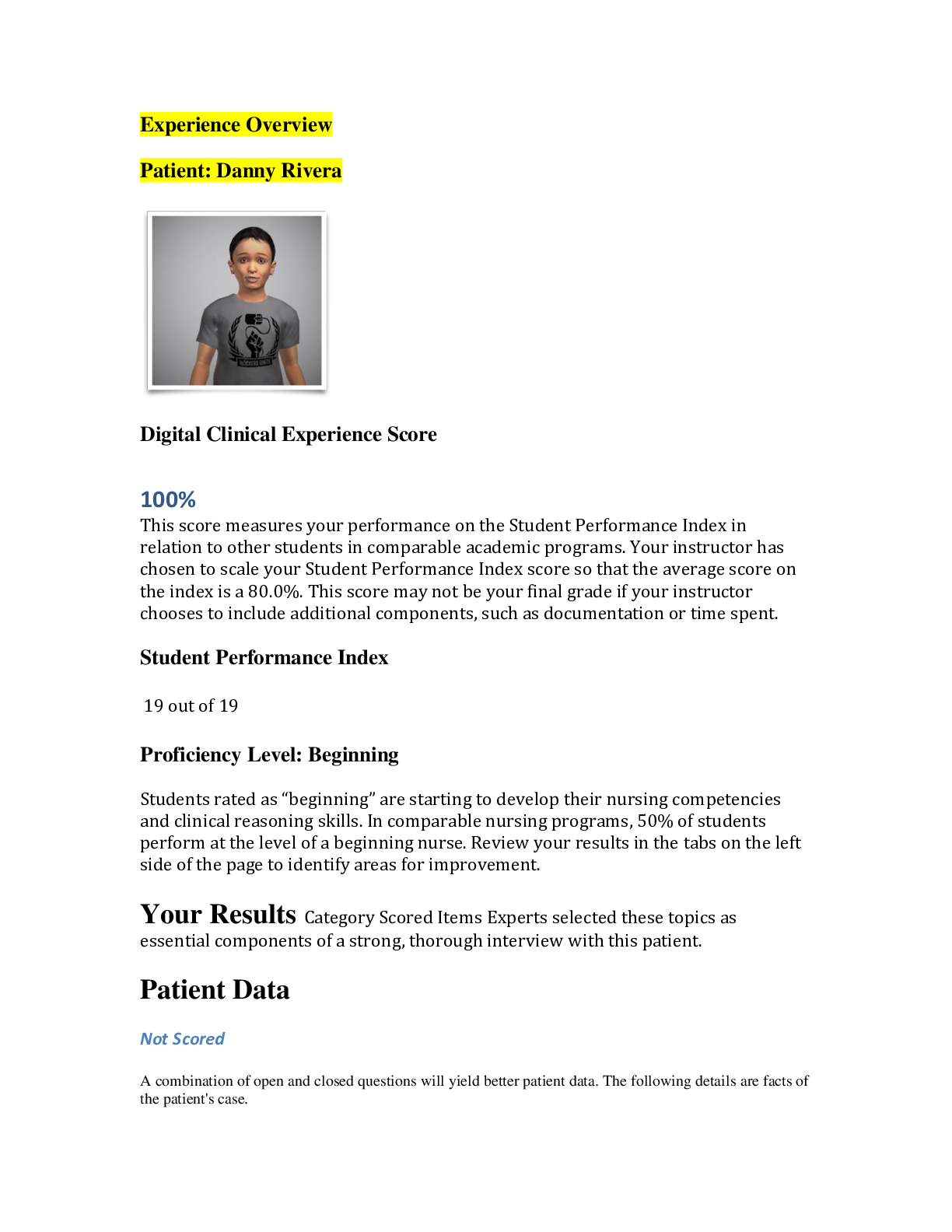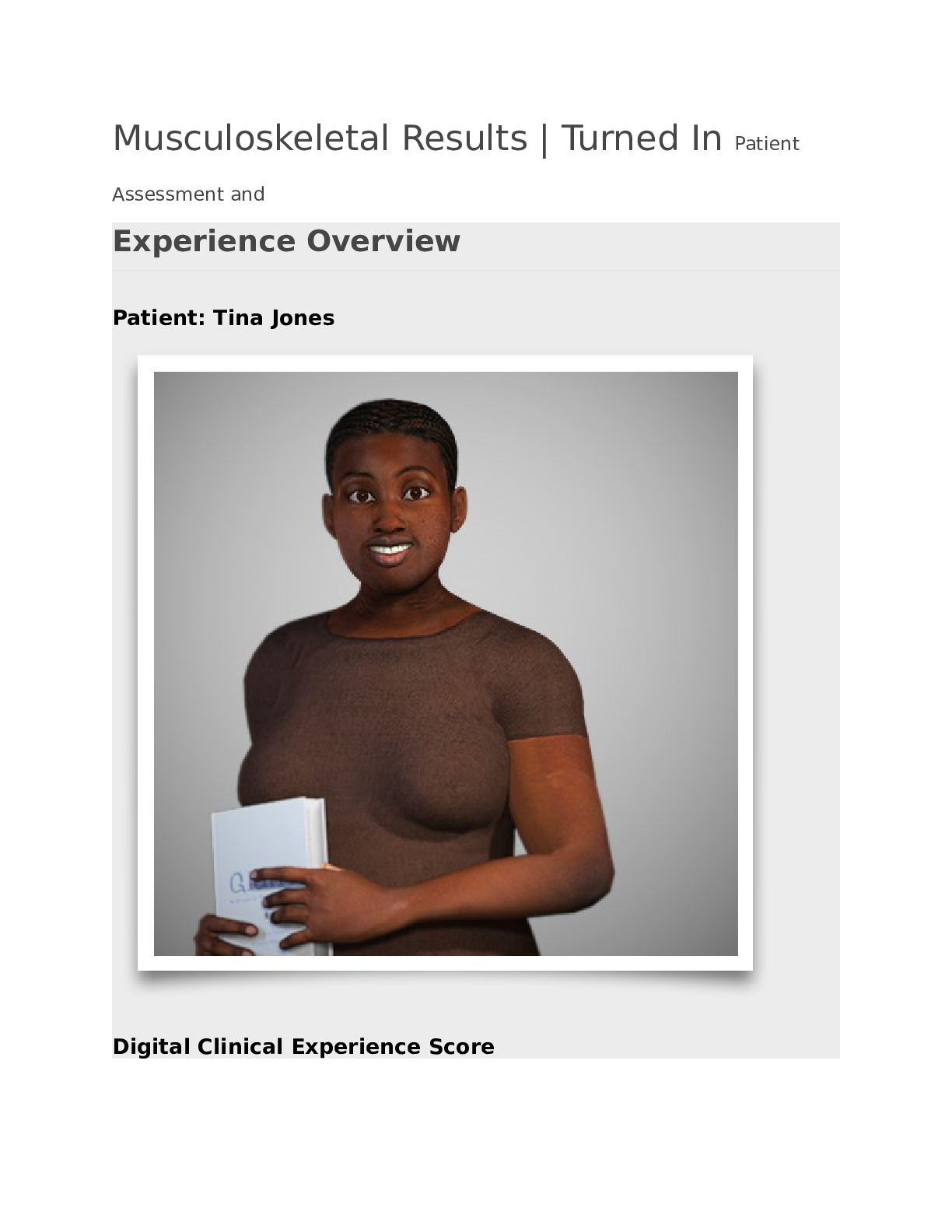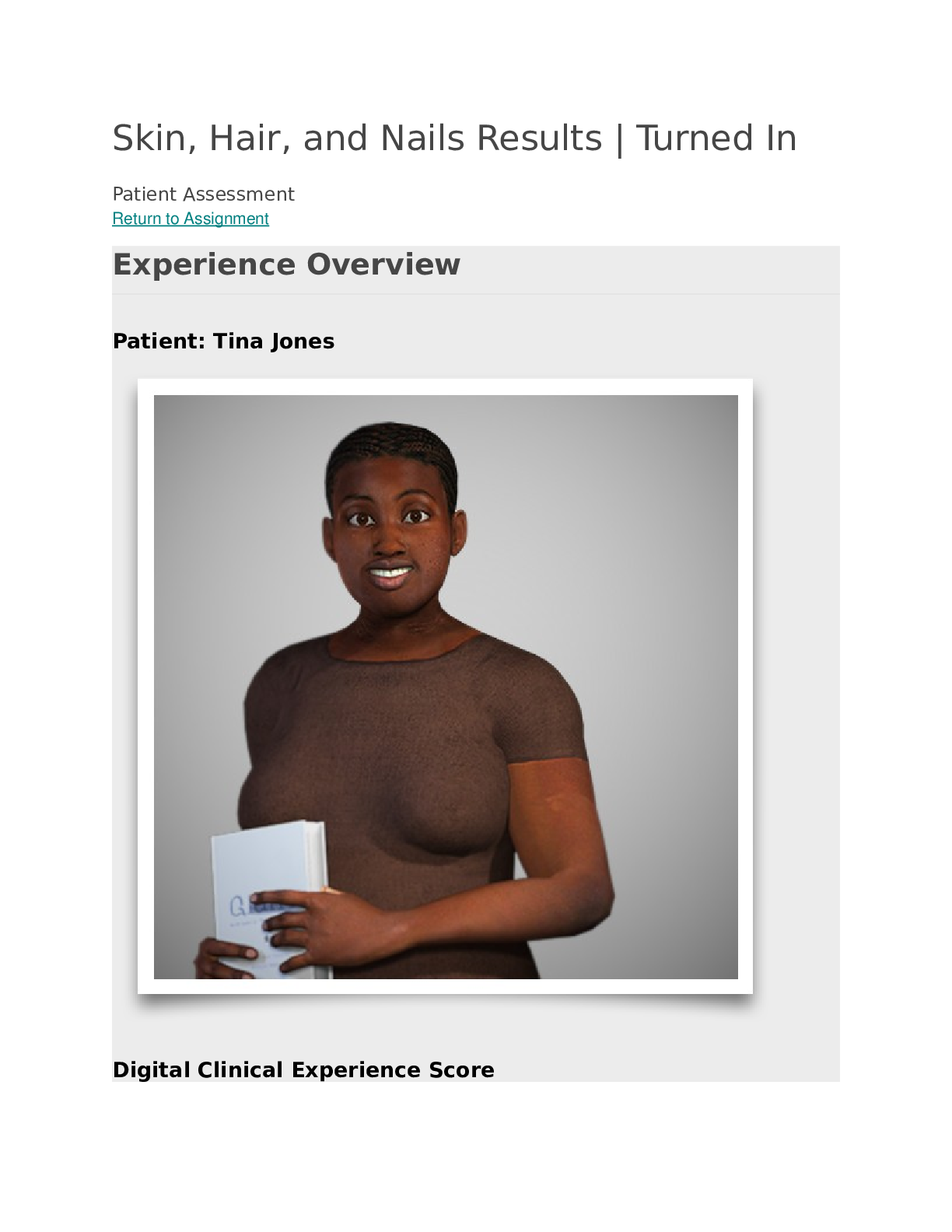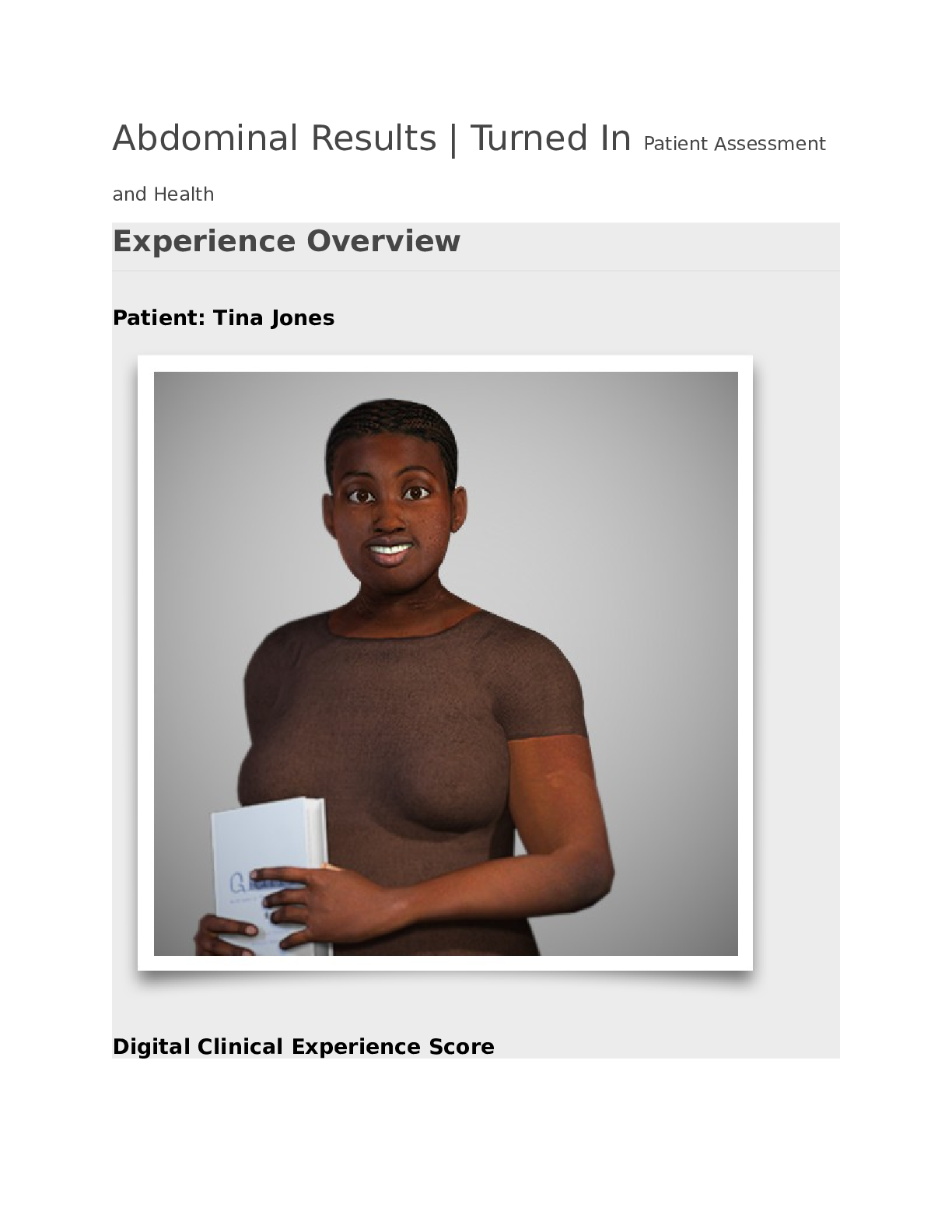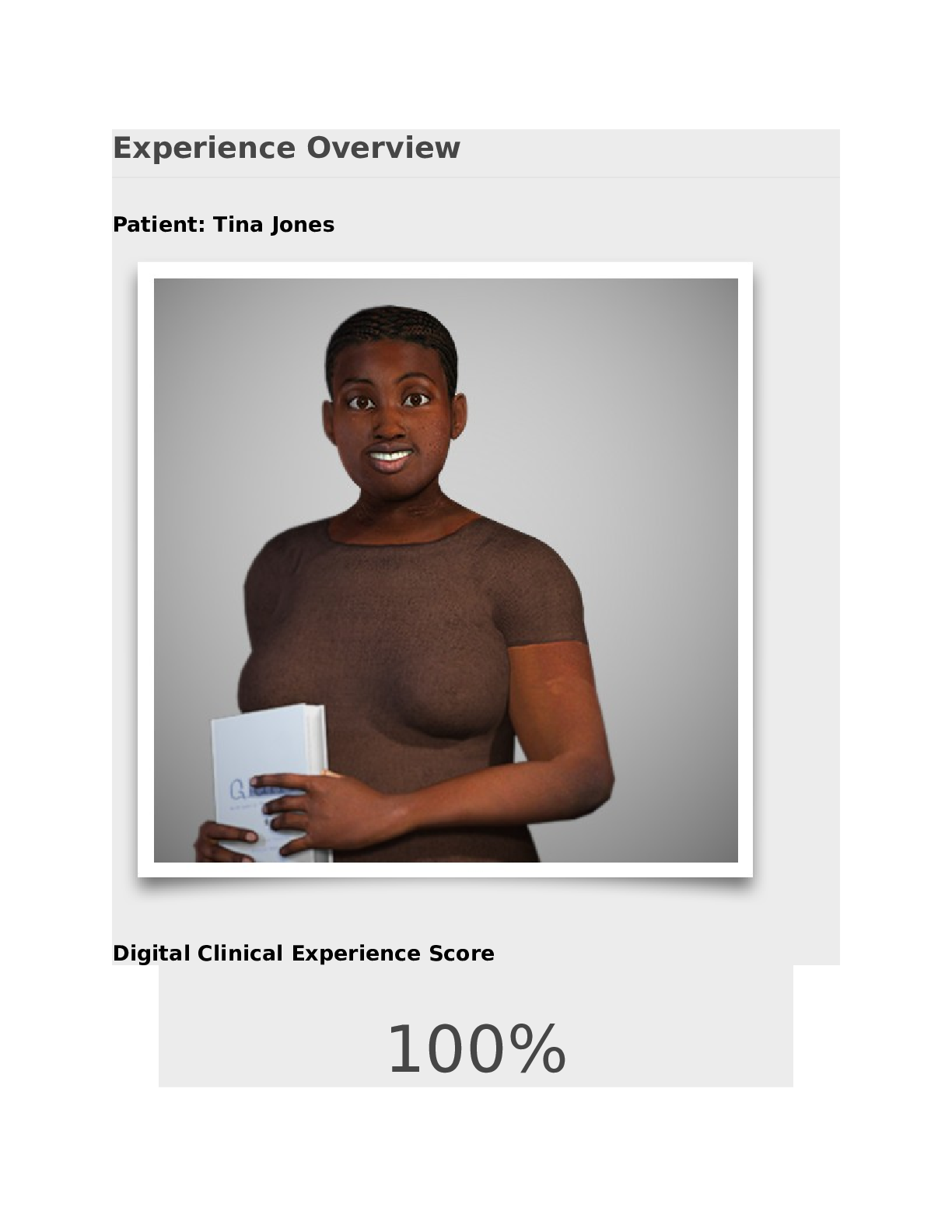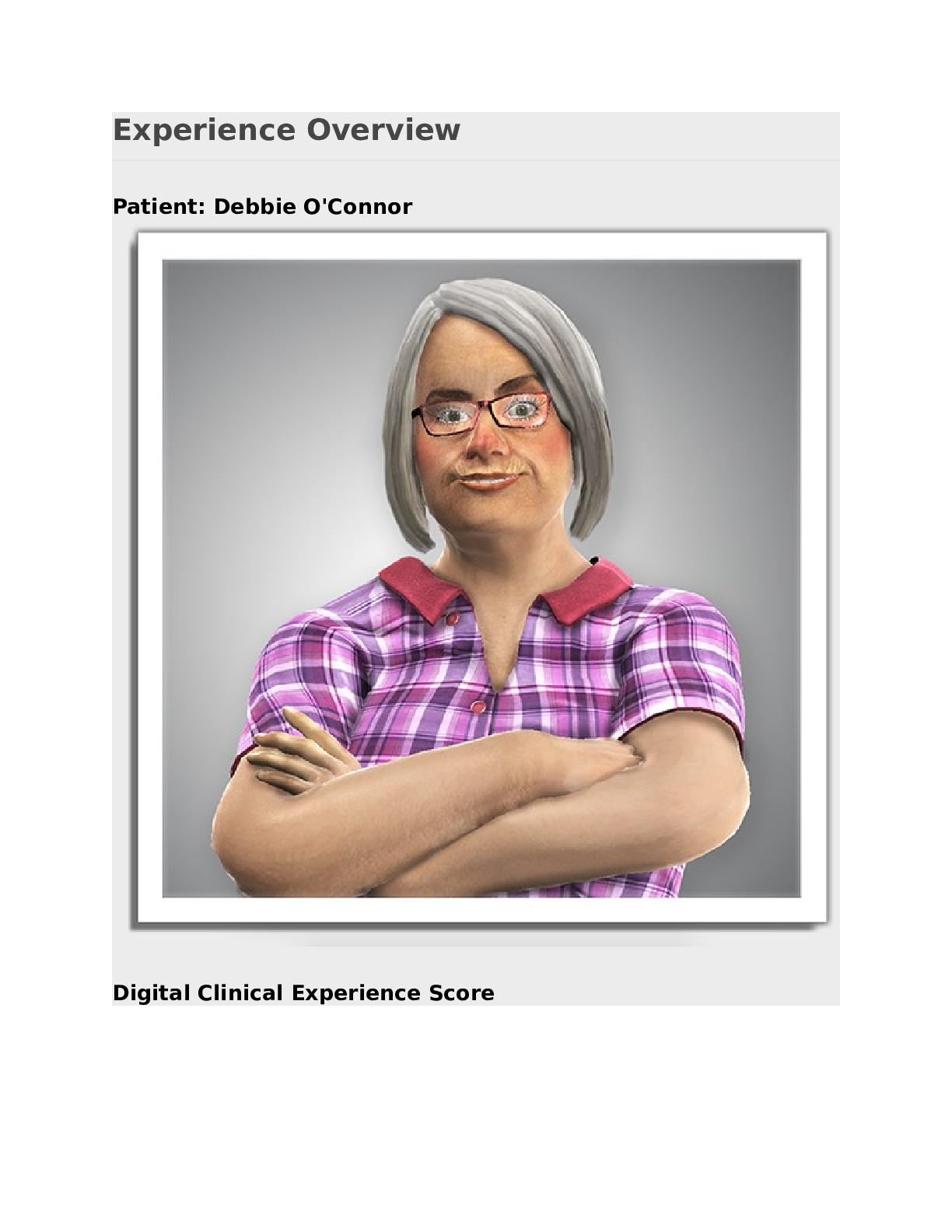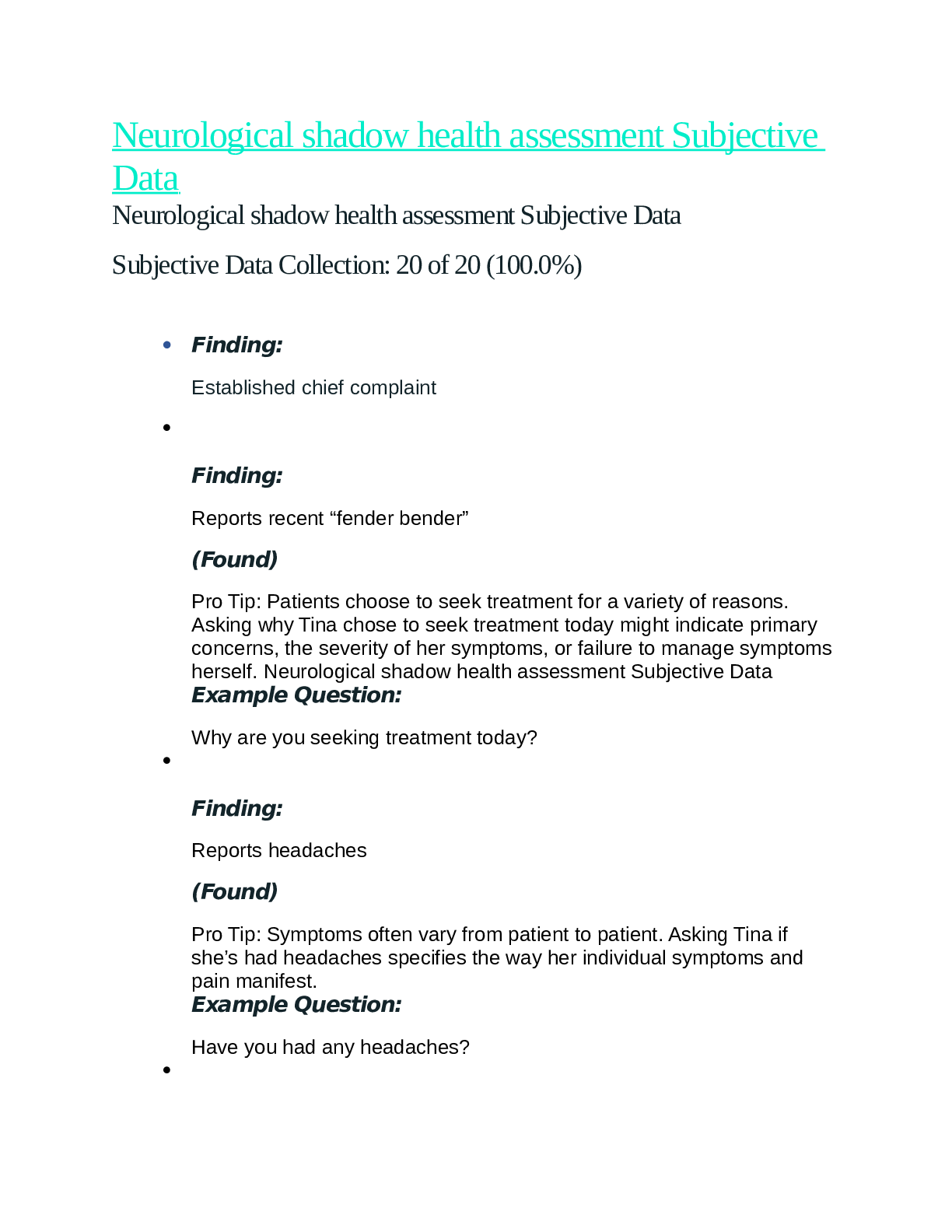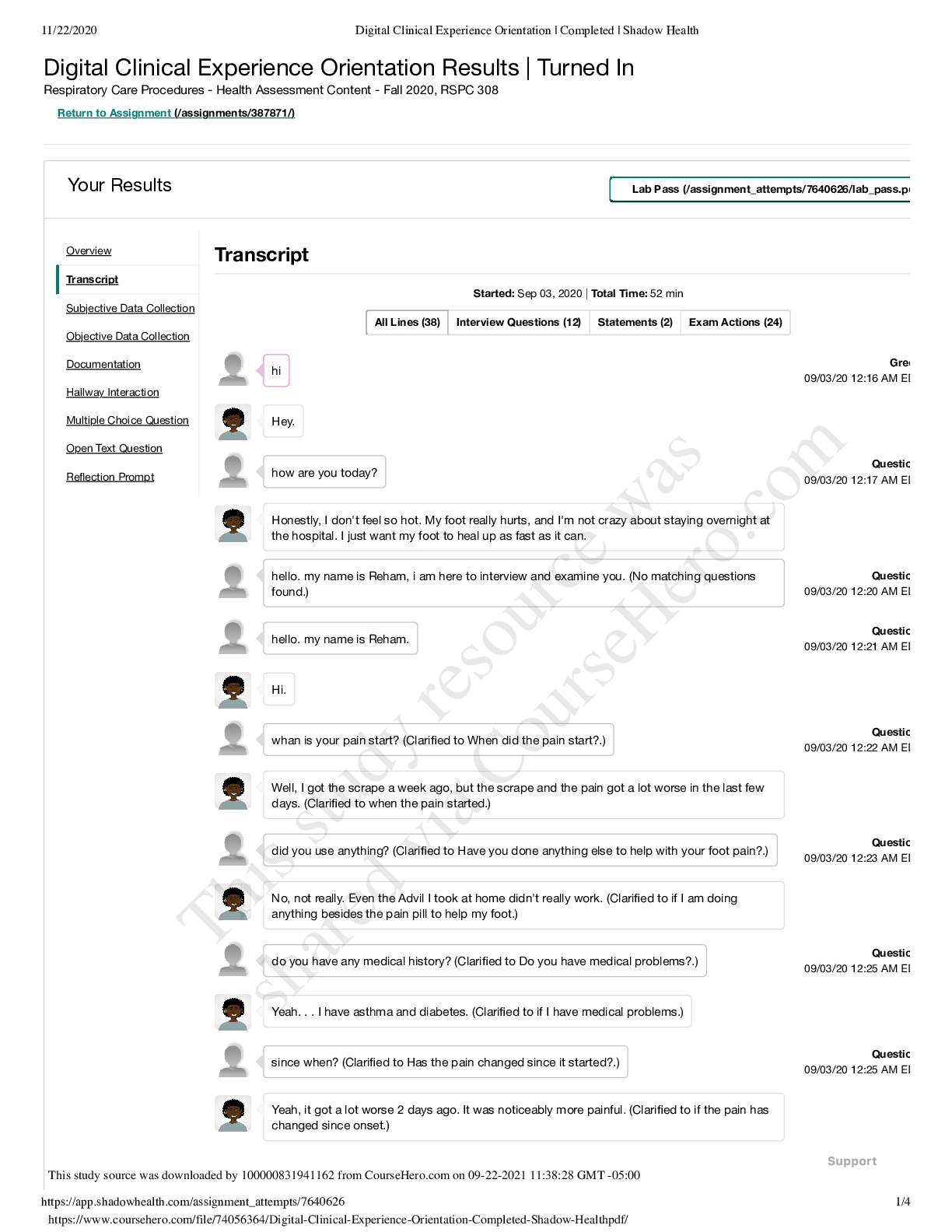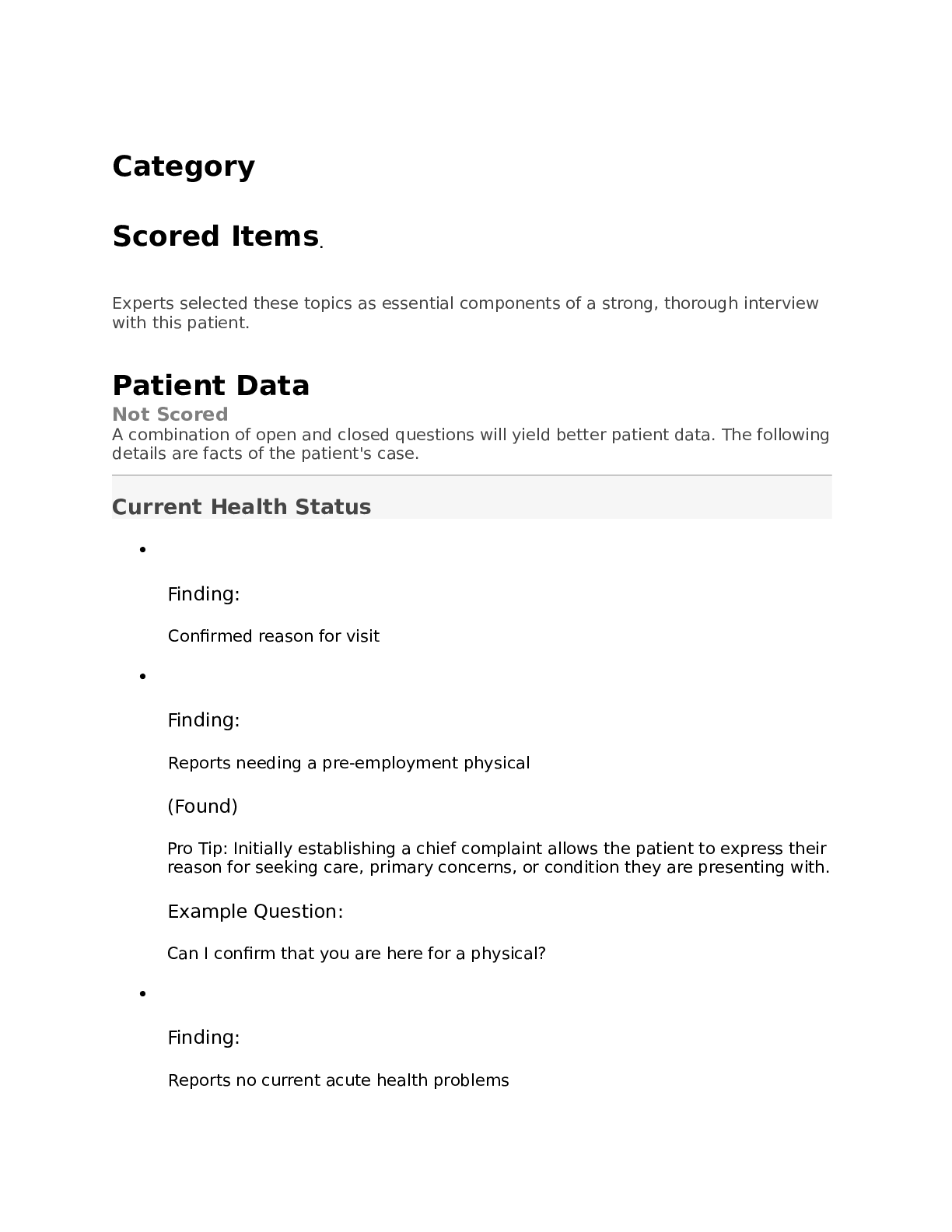*NURSING > SHADOW HEALTH > Nursing Concepts Shadow Health Assessment 2018, Nur 112 Patient: Tina Jones Digital Clinical Experie (All)
Nursing Concepts Shadow Health Assessment 2018, Nur 112 Patient: Tina Jones Digital Clinical Experience Score 100% Student Performance Index 50 out of 51
Document Content and Description Below
Nursing Concepts Shadow Health Assessment 2018, Nur 112 Patient: Tina Jones Digital Clinical Experience Score 100% Student Performance Index 50 out of 51 Musculoskeletal Results | Turned In Nursing ... Concepts Shadow Health Assessment 2018, Nur 112 Patient: Tina Jones Digital Clinical Experience Score 100% Student Performance Index 50 out of 51 Subjective Data Collection 23 out of 23 Objective Data Collection 27 out of 28 Time 57 minutes total spent in assignment Hello! Question 11/09/18 12:00 AM CST Hi. I'm Preceptor Diana. I will explain the details of this assignment and your objectives, just as a preceptor would in real life. Pay close attention to this information as it will help guide your exam. At the end of this prebrief, you will answer a short question about the upcoming assignment. During the simulation, you may return to these instructions at any time by scrolling to the top of your transcript. What is the situation? Question 11/09/18 12:03 AMCST It's 8 a.m. on Tina Jones' second morning as a patient here at Shadow General Hospital. Ms. Jones has a physical therapy consultation later today. Your role in this simulation is that of healthcare provider who will perform a full musculoskeletal system exam on Ms. Jones so that her therapist can understand Ms. Jones' musculoskeletal health and customize therapy accordingly. What are my objectives in this assessment? Question 11/09/18 12:05 AM CST In your interview with Ms. Jones, you will ask about her musculoskeletal system and identify any risk factors or complications. If you discover any disease states, ask about symptoms and the patient's experiences of them. Your questioning should cover a broad array of the symptoms' characteristics. You will also inquire into the health history of Ms. Jones' family with regards to the musculoskeletal system so you can determine her genetic predisposition to any diseases. Regardless of whether you have assessed Tina previously, ask all questions that are medically relevant to her musculoskeletal system. In addition to collecting subjective data, you will perform a physical exam on Ms. Jones' musculoskeletal system to gather objective data about the system's health and physiology. While you should communicate with patients using accessible, everyday language, it is standard practice to use professional medical terminology everywhere else, such as in documenting physical findings and nursing notes. You may complete the exam activities in any order and move between them as needed. What else will this exam involve? Question 11/09/18 12:07 AM CST You will complete nursing tasks to protect the patients safety, privacy, and health. You can document your findings, including vital signs, in the Electronic Health Record. This record provides necessary information for healthcare professionals who will continue patient care. Activities other than Subjective and Objective Data Collection, such as Documentation and Education and Empathy, provide valuable practice for their real-world counterparts. However,they are not automatically graded by the simulation. How will I be evaluated? Question 11/09/18 12:10 AM CST In this assignment, you will be evaluated on your Subjective and Objective Data Collection. The evaluation of your interview is dependent on how you word your questions therapeutically and precisely and explore all relevant topics with comprehensive breadth and depth. The evaluation of your physical exam is based on how successfully you report on your physical findings by selecting among clinical terms in the Electronic Health Record. This assignment takes on average between 50 and 60 minutes. You can pause and resume the assignment at any time; your work is always saved automatically. How does this assignment prepare me for the real world? Question 11/09/18 12:13 AM CST In this assessment, you will become familiarized with the structure and content of musculoskeletal exams so that with real-life patients, you can: º ask effective and comprehensive questions º use therapeutic language º evaluate the patient's risk of disease, infection, injury, and complications º and obtain and assess objective data. In 1 or 2 sentences, answer this question to help prepare for the upcoming exam: What precautions should you take with a patient that is a fall risk? Keep the call light within reach, remove all tripping or slipping hazards, make sure the bed isn't too high. Question 11/09/18 12:20 AM CST Time to begin. Hi, my name is Kara and I will be taking care of you today Greet 11/09/18 12:20 AM CSTHey. Can you confirm your name? Question 11/09/18 12:21 AM CST Tina Jones. What brings you in today? Question 11/09/18 12:58 AM CST Uh, I came in two nights ago because my foot was hurting. They said it was infected. How have you been treating the foot infection at home? Question 11/09/18 12:58 AM CST I made sure to clean it and keep it bandaged. And I put Neosporin on it. Can you rate your pain level on a scale from 0-10? (Clarified to Can you rate your current pain level on a scale of 0 to 10?.) Question 11/09/18 12:58 AM CST I'd give it a 5 or 6 out of 10 right now. (Clarified to how I would rate my pain on a scale.) Did you receive any pain medication? (Clarified to have you taken medication for the pain.) Question 11/09/18 12:59 AM CST I've been getting pain medication, yeah. (Clarified to if I took medication for the pain.) Do you have any joint problems? Question 11/09/18 1:00 AM CST No, my joints are fine.Do you have any joint stiffness? Question 11/09/18 1:00 AM CST No, I'm not stiff anywhere now. Do you have any back pain? Question 11/09/18 1:00 AM CST No, I don't usually have back pain. What is your pain level while walking? (Clarified to what is your pain like when you try to walk.) Question 11/09/18 1:01 AM CST It still hurts a lot to put weight on my foot, but I can do it now without help, at least. (Clarified to what my pain is like when I try to walk.) Are you able to stand? Question 11/09/18 1:01 AM CST Last time I tried to stand normally it really hurt my foot, but at least I was able to stand on it. I'm hoping it'll be better soon. Did you need help standing up? (No matching questions found.) Question 11/09/18 1:02 AM CST Did you need assistance standing up? (No matching questions found.) Question 11/09/18 1:02 AM CSTAre you experiencing any sore muscles? Question 11/09/18 1:02 AM CST My muscles don't really get sore ever. Do your joints around your injury hurt? Question 11/09/18 1:03 AM CST It hurts my foot a little to move my ankle, but my ankle feels fine. What do you do for a living? Question 11/09/18 1:03 AM CST I'm a supervisor at Mid-American Copy & Ship. I've been working there since high school, and I've just kept moving up. Do you stand often at work? Question 11/09/18 1:04 AM CST I usually have to be on my feet my whole shift at work, which is why I've had to call in sick since my foot started hurting too much to put weight on. How long were you on your feet at work? (No matching questions found.) Question 11/09/18 1:04 AM CST Are you able to perform daily tasks without help? (Clarified to Are you able to perform all of your usual daily activities?.) Question 11/09/18 1:05 AM CST I couldn't really do much at all the last couple days without help. I'm glad my mom and sister were there to help, and the nurses here,too. Now, though, I feel like I can start to do things for myself again. My foot still hurts, but not nearly as bad. (Clarified to if I am able to perform daily activities.) HAve you had any muscle injuries? Question 11/09/18 1:06 AM CST No, I don't think so. Have you had any joint injuries? Question 11/09/18 1:08 AM CST No, not really. Any history of fractures? Question 11/09/18 1:08 AM CST I've never broken a bone or anything like that. Any history of sprains? Question 11/09/18 1:09 AM CST I can't remember spraining anything before. . . maybe in grade school? I did something to one of my fingers playing tether ball, I think. But nothing since then. Any muscle problems? Question 11/09/18 1:09 AM CST I don't have any problems with my muscles. Do you have any issues with your neck? Question 11/09/18 1:10 AMCST My neck feels normal to me. Do you have a history of falls? Question 11/09/18 1:11 AM CST Last week was the only time I can really remember falling. Where were you when you fell? Question 11/09/18 1:11 AM CST I was at home, in our living room, changing that light bulb. Did you get dizzy before you fell? Question 11/09/18 1:11 AM CST No, I wasn't dizzy. How did you feel before you fell? (Clarified to was your foot hurt before you fell.) Question 11/09/18 1:11 AM CST Everything was fine with my foot before I got the scrape. (Clarified to if my foot was hurt before I fell.) Have you had any other injuries recently? (Clarified to Do you have any other injuries?.) Question 11/09/18 1:12 AM CST Nope. It's kind of amazing, but I didn't hurt my hands, knees, nothing else. Just my foot. (Clarified to if I have other injuries.) Did you scrape your foot when you fell? Question 11/09/18 1:12 AMCST Yeah. Any family history of osteoporosis? Question 11/09/18 1:13 AM CST No one in the family has osteoporosis that I know of. any family history of joint problems? Question 11/09/18 1:13 AM CST I don't know of any joint problems in the family. Any arthritis? Question 11/09/18 1:13 AM CST No, I don't have arthritis! I'm a little young for that. . . Any family history of bone cancer? Question 11/09/18 1:14 AM CST Oh wow -- no, not that I know of. Subjectve Data Collecton: 23 of 23 (100.0%) Hover To Reveal... Hover over the Patent Data items below to reveal important informaton, including Pro Tips and Example Questons. Found: Indicates an item that you found. Available: Indicates an item that is available to be found.Category Scored Items Experts selected these topics as essental components of a strong, thorough interview with this patent. Patent Data Not Scored A combinaton of open and closed questons will yield beter patent data. The following details are facts of the patent's case. Relevant Medical History Finding: Asked about joint problems Finding: Denies joint pain (Available) Pro Tip: Uncovering if Tina has any joint pain is important, as they could be a result of her recent foot injury and could contribute to impaired mobility. Example Queston: Do you have joint pain? Finding: Denies joint swelling (Found) Pro Tip: Uncovering if Tina has any swollen joints is important, as they could be a result of her recent foot injury and could contribute to impaired mobility. Example Queston: Do you have swollen joints? Finding: Asked about mobility Finding: Denies history of walking problems (Found)Pro Tip: Discovering if Tina has a history of walking problems is imperatve because it could show that her mobility issues predate the foot wound. Example Queston: Have you ever had problems walking? Finding: Reports recent foot wound hindered mobility (Available) Pro Tip: People with severe pain might fnd that they are limited in their movements. Asking Tina whether the pain makes it hard for her to walk would illustrate whether her pain is preventng her from some of the actvites that comprise her daily life. Example Queston: Has your wound affected your mobility? Finding: Reports ability to walk on foot has recently improved (Found) Pro Tip: Determining if Tina's mobility has recently improved will provide key informaton as to the healing process and what further steps are needed. Example Queston: Has your mobility changed lately? Finding: Asked pain ratng when walking Finding: Reports pain as a 7 or 8/10 when walking (Available) Pro Tip: People with severe pain might fnd that they are limited in their movements. Having Tina rank her pain on a scale will help you judge the severity of the wound and help you determine treatment needs. Example Queston: How would you rate your pain when walking? Finding: Asked about ability to stand Finding: Denies trouble standing before foot problems (Found) Pro Tip: Asking Tina if she has a history of standing problems will reveal the severity of her injury and whether her standing problem predated her foot injury. Example Queston: Do you have a history of standing problems? Finding: Reports recent foot wound hindered standing (Found) Pro Tip: Asking Tina if she can stand on her foot will reveal the severity of her injury and whether or not she is able to put weight on her foot. Example Queston: Has your wound affected your ability to stand? Finding: Reports improved ability to stand on injured foot (Found) Pro Tip: Asking Tina if she can stand on her foot will reveal the severity of her injury and whether or not she is able to put weight on her foot. Example Queston: Are you able to stand on your foot? Finding: Asked pain ratng when standing Finding: Reports pain as a 7 or 8/10 when bearing weight on foot (Available) Pro Tip: Asking Tina about the pain if she's standing will reveal the severity of her injury and whether or not standing exacerbates her pain. Example Queston: How would you rate your pain on a scale of 1 to 10 when you are standing? Finding: Asked about muscle soreness Finding: Denies history of muscle soreness (Found) Pro Tip: Symptoms ofen vary from patent to patent. Asking Tina if she has ever had muscle soreness specifes the way her symptoms and pain manifest. Example Queston: Have you ever had muscle soreness? Finding: Denies current muscle soreness (Available) Pro Tip: Symptoms ofen vary from patent to patent. Asking Tina if she is having muscle soreness specifes the way her symptoms and pain manifest. Example Queston: Are you having muscle soreness? Finding: Asked about joints in proximity of injury Finding: Denies current ankle problems (Found) Pro Tip: Ankle problems can greatly affect a patent's mobility. Asking Tina if she has problems with her ankles can reveal a major health concern. Example Queston: Are your ankles giving you trouble? Finding: Asked about occupatonal impact on injury Finding: Denies work being dangerous (Available)Pro Tip: Determining if Tina's workplace is safe will allow you to establish any occupatonal dangers that could exacerbate her current health issues or pose further risks. Example Queston: Is your work dangerous? Finding: Denies work involving repettve moton (Available) Pro Tip: Establishing if Tina's job requires repettve moton, such as picking up boxes, can help you determine if those motons have had an impact on her health or pose potental risks. Example Queston: Does your work involve repettve moton? Finding: Reports foot wound prevented her from working (Found) Pro Tip: People with severe pain might fnd that they are unable to perform all of their daily actvites. Asking Tina whether she has been able to work in spite of the pain would illustrate whether her pain is preventng her from actvites that consttute her daily life. Example Queston: Did your wound prevent you from working? Finding: Asked about actvites of daily living Finding: Denies difculty transferring from sitng to standing (Found) Pro Tip: As a result of Tina's foot would, there is the risk that certain actvites of daily living have been compromised. It is important to identfy any difcultes with transferring so her quality of life does not suffer. Example Queston: Are you able to go from sitng to standing? Finding: Denies difculty bathing(Available) Pro Tip: As a result of Tina's foot would, there is the risk that certain actvites of daily living have been compromised. It is important to identfy any difcultes with bathing so her quality of life does not suffer. Example Queston: Can you bathe yourself? Review of Systems Finding: Asked about joint stffness Finding: Denies joint stffness (Available) Pro Tip: Because Tina's foot wound has recently impaired mobility, which ofen leads to joint stffness, it is important to ask Tina about her joints to ascertain the impact of her wound and what treatment she may require. Example Queston: Do you feel stff anywhere? Finding: Asked about back pain Finding: Denies history of back pain (Available) Pro Tip: Back pain can be a serious complaint that compromises a patent's quality of life. It is important to determine Tina has suffered from back pain so you can most effectvely treat the issue. Example Queston: Have you had back pain before? Finding: Denies current back pain (Found) Pro Tip: Back pain can be a serious complaint that compromises a patent's quality of life. It is important to determine if Tina is currently suffering from back pain so you can most effectvely treat the issue.Example Queston: Are you having back pain? Finding: Asked about muscle injury Finding: Denies history of muscle injury (Found) Pro Tip: It is important to establish if Tina has a history of muscle injuries because it may contribute to her recent mobility issues. Example Queston: Have you ever had a muscle injury? Finding: Denies current muscle injury (Found) Pro Tip: It is important to establish if Tina has a muscle injury because it might contribute to her recent mobility issues. Example Queston: Do you have a muscle injury? Finding: Asked about joint injury Finding: Denies past joint injury (Found) Pro Tip: It is important to establish if Tina has a history of joint injuries because it may contribute to her recent mobility issues. Example Queston: Have you experienced a joint injury in the past? Finding: Denies current joint injury (Found)Pro Tip: It is important to establish if Tina has a joint injury because it might contribute to her recent mobility issues. Example Queston: Do you have a joint injury? Finding: Asked history of fracture Finding: Denies history of fractures (Found) Pro Tip: Solicitng your patent's medical history can help you to understand the nature of a patent's chief complaint. Asking Tina whether she's ever broken a bone might reveal relevant concerns she'd previously experienced. Example Queston: Have you ever broken a bone? Finding: Asked history of sprains Finding: Denies history of sprains (Found) Pro Tip: Solicitng your patent's medical history can help you to understand the nature of a patent's chief complaint. Asking Tina whether she has a history of getng sprains might reveal relevant concerns she'd previously experienced. Example Queston: Do you have a history of getng sprains? Finding: Asked about bone problems Finding: Denies history of bone problems (Found)Pro Tip: Solicitng your patent's medical history can help you to understand the nature of a patent's chief complaint. Asking Tina whether she ever had bone problems might reveal relevant concerns she'd previously experienced. Example Queston: Have you ever had bone problems? Finding: Denies current bone problems (Available) Pro Tip: Solicitng your patent's medical history can help you to understand the nature of a patent's chief complaint. Asking Tina whether she has bone problems might reveal relevant concerns she'd previously experienced. Example Queston: Do you have bone problems? Finding: Asked about neck Finding: Denies history of neck problems (Found) Pro Tip: A history of neck problems may imply an illness or a problematc behavior in the patent. Asking Tina whether she has had neck problems in the past could prompt you to follow up on potental causes. Example Queston: Have you had neck problems? Finding: Denies current neck problems (Found) Pro Tip: Symptoms ofen vary from patent to patent. Asking Tina about the symptoms she may be experiencing with her injury, like neck pain, details the way her individual symptoms and pain manifest. Example Queston: Do you have neck problems? Finding: Asked about range of moton of body parts Finding: Reports normal range of moton (Found) Pro Tip: People with severe pain might fnd that they are limited in their movements. Asking Tina whether she is limited in her movements would illustrate whether her pain is preventng her from some of the actvites that comprise her daily life. Example Queston: Do you have full range of moton? Finding: Asked about muscle problems Finding: Denies muscle weakness (Found) Pro Tip: Symptoms ofen vary from patent to patent. Asking Tina about the symptoms she is experiencing with her injury, like muscle weakness, details the way her individual symptoms and pain manifest. Example Queston: Are you experiencing any muscle weakness? Finding: Denies muscle cramping (Available) Pro Tip: Symptoms ofen vary from patent to patent. Asking Tina about the symptoms she is experiencing with her injury, like muscle cramping, details the way her individual symptoms and pain manifest. Example Queston: Are you experiencing any muscle cramping? Risk Factors Finding: Asked fall history Finding: Reports fall(Found) Pro Tip: Changes in bone compositon can leave a patent more at risk for falling. Asking Tina about her history of falling could provide you with informaton about her bone density. Example Queston: Have you fallen before? Finding: Reports fall was one week ago (Found) Pro Tip: Changes in bone compositon can leave a patent more at risk for falling. Asking Tina about her history of falling could provide you with informaton about her bone density. Example Queston: When was the last tme you fell? Finding: Reports belief that she is not partcularly prone to falls (Found) Pro Tip: Changes in bone compositon can leave a patent more at risk for falling. Asking Tina if she is prone to falling could provide you with informaton about her bone density. Example Queston: Are you prone to falling? Relevant Family History Finding: Asked family history of osteoporosis Finding: Denies family history of osteoporosis (Found) Pro Tip: Family histories can suggest a genetc predispositon. Asking Tina if anyone in her family has osteoporosis can indicate a potental predispositon. Example Queston: Does anyone in your family have osteoporosis? Finding:Asked family history of joint problems Finding: Denies family history of joint problems (Found) Pro Tip: Family histories can suggest a genetc predispositon. Asking Tina if anyone in her family has had joint problems can indicate a potental predispositon. Example Queston: Has anyone in your family had joint problems? Finding: Denies family history of arthrits (Available) Pro Tip: Family histories can suggest a genetc predispositon. Asking Tina if anyone in her family has arthrits can indicate a potental predispositon. Example Queston: Does arthrits run in your family? Finding: Asked family history of bone cancer Finding: Denies family history of bone cancer (Found) Pro Tip: Family histories can suggest a genetc predispositon. Asking Tina if anyone in her family has a history of bone cancer can indicate a potental predispositon. Example Queston: Has anyone in your family had bone cancer? Objective Data Collection: 27 of 28 (96.43%) Inspected neck 1 of 1 point Symmetry (1/2 point) Symmetric Asymmetric Appearance (1/2 point) No visible abnormal findings Swelling Visible pulsation Visible mass Irregular alignment Discoloration Inspected shoulders 1 of 1 point Symmetry (1/3 point) Symmetric bilaterally Asymmetric Right: Appearance (1/3 point) No visible abnormal findings Swelling Visible mass Irregular alignment Discoloration Left: Appearance (1/3 point) No visible abnormal findings Swelling Visible mass Irregular alignment Discoloration Inspected arms 1 of 1 point Symmetry (1/3 point) Symmetric bilaterally AsymmetricRight: Appearance (1/3 point) No visible abnormal findings Swelling Visible mass Irregular alignment Discoloration Atrophy Hypertrophy Left: Appearance (1/3 point) No visible abnormal findings Swelling Visible mass Irregular alignment Discoloration Atrophy Hypertrophy Inspected elbows 1 of 1 point Symmetry (1/3 point) Symmetric bilaterally Asymmetric Right: Appearance (1/3 point) No visible abnormal findings Swelling Visible mass Irregular alignment Discoloration Joint deformity Left: Appearance (1/3 point) No visible abnormal findings Swelling Visible mass Irregular alignment Discoloration Joint deformityInspected wrists 1 of 1 point Symmetry (1/3 point) Symmetric bilaterally Asymmetric Right: Appearance (1/3 point) No visible abnormal findings Swelling Visible mass Irregular alignment Discoloration Atrophy Hypertrophy Joint deformity Left: Appearance (1/3 point) No visible abnormal findings Swelling Visible mass Irregular alignment Discoloration Atrophy Hypertrophy Joint deformity Inspected hands and fingers 0.33 of 1 point Symmetry (1/3 point) Symmetric bilaterally Asymmetric Right: Appearance (No point) No visible abnormal findings Swelling Visible mass Irregular alignment Discoloration Joint deformity Left: Appearance (No point) No visible abnormal findings Swelling Visible mass Irregular alignment Discoloration Joint deformity Inspected hips 1 of 1 point Appearance (1/1 point) No visible abnormal findings Swelling Visible mass Irregular alignment Discoloration Pelvic tilt Inspected thighs 1 of 1 point Symmetry (1/3 point) Symmetric bilaterally Asymmetric Right: Appearance (1/3 point) No visible abnormal findings Swelling Visible mass Irregular alignment Discoloration Atrophy Hypertrophy Left: Appearance (1/3 point) No visible abnormal findings Swelling Visible mass Irregular alignment Discoloration Atrophy Hypertrophy Inspected knees 0.67 of 1 point Symmetry (1/3 point) Symmetric bilaterally Asymmetric Right: Appearance (No point) No visible abnormal findings Swelling Visible mass Genu recurvatum Discoloration Joint deformity Left: Appearance (1/3 point) No visible abnormal findings Swelling Visible mass Genu recurvatum Discoloration Joint deformity Inspected lower legs 1 of 1 point Symmetry (1/3 point) Symmetric bilaterally Asymmetric Right: Appearance (1/3 point) No visible abnormal findings Swelling Visible mass Discoloration Atrophy Hypertrophy Genu valgum Genu varum Left: Appearance (1/3 point) No visible abnormal findings Swelling Visible mass Discoloration Atrophy Hypertrophy Genu valgum Genu varum Inspected ankles 1 of 1 point Symmetry (1/3 point) Symmetric bilaterally Asymmetric Right: Appearance (1/3 point) No visible abnormal findings Swelling Visible mass Irregular alignment Discoloration Joint deformity Left: Appearance (1/3 point) No visible abnormal findings Swelling Visible mass Irregular alignment Discoloration Joint deformityInspected feet 1 of 1 point Symmetry (1/5 point) Symmetric bilaterally Asymmetric Right: Appearance (1/5 point) No visible abnormal findings Swelling Laceration, lesion, or wound Visible mass Irregular alignment Discoloration Joint deformity Hallux valgus Hammertoe(s) Mallet toe(s) Claw toe(s) Right: Arch Shape (1/5 point) Expected curvature Pes planus Pes cavus Left: Appearance (1/5 point) No visible abnormal findings Swelling Laceration, lesion, or wound Visible mass Irregular alignment Discoloration Joint deformity Hallux valgus Hammertoe(s) Mallet toe(s) Claw toe(s) Left: Arch Shape (1/5 point) Expected curvature Pes planus Pes cavus Tested neck range of motion 1 of 1 point Extension (1/4 point) Expected range of motion (approx. 45 degrees) Reduced range of motion Flexion (1/4 point) Expected range of motion (approx. 45 degrees) Reduced range of motion Lateral Bending (1/4 point) Expected range of motion (approx. 40 degrees) on both sides Reduced range of motion on right Reduced range of motion on left Rotation (1/4 point) Expected range of motion (approx. 70 degrees) on both sides Reduced range of motion on right Reduced range of motion on left Tested shoulder range of motion 1 of 1 point Adduction (1/3 point) Expected range of motion (approx. 50 degrees) Reduced range of motion Extension (1/3 point) Expected range of motion (approx. 50 degrees) Reduced range of motion Forward Flexion (1/3 point) Expected range of motion (approx. 180 degrees) Reduced range of motion Tested elbow range of motion 1 of 1 point Right: Flexion And Extension (1/4 point) Expected range of motion (approx. flexion of 160 degrees and 180 of full extension) Reduced flexion Reduced extension Left: Flexion And Extension (1/4 point) Expected range of motion (approx. flexion of 160 degrees and 180 of full extension) Reduced flexion Reduced extension Right: Supination And Pronation (1/4 point) Expected range of motion (approx. pronation of 90 degrees and supination of 90 degrees) Reduced pronation Reduced supination Left: Supination And Pronation (1/4 point) Expected range of motion (approx. pronation of 90 degrees and supination of 90 degrees) Reduced pronation Reduced supination Tested wrist range of motion 1 of 1 point Right: Ulnar And Radial Deviation (1/6 point) Expected range of motion (approx. ulnar radiation 55 degrees and radial deviation 90 degrees) Reduced ulnar deviation Reduced radial deviation Left: Ulnar And Radial Deviation (1/6 point) Expected range of motion (approx. ulnar radiation 55 degrees and radial deviation 90 degrees) Reduced ulnar deviation Reduced radial deviation Right: Extension (1/6 point) Expected range of motion (approx. 70 degrees) Reduced extension Left: Extension (1/6 point) Expected range of motion (approx. 70 degrees) Reduced extension Right: Flexion (1/6 point) Expected range of motion (approx. 90 degrees) Reduced flexion Left: Flexion (1/6 point) Expected range of motion (approx. 90 degrees) Reduced flexion Tested spine range of motion 1 of 1 point Extension (1/4 point) Expected range of motion (approx. 30 degrees) Reduced extension Flexion (1/4 point) Expected range of motion (approx. 75 - 90 degrees) Reduced flexion Lateral Bending (1/4 point) Expected range of motion bilaterally (approx. 35 degrees) Reduced lateral bending to the right Reduced lateral bending to the left Rotation (1/4 point) Expected range of motion bilaterally (approx. 30 degrees) Reduced rotation to the right Reduced rotation to the left Tested hip range of motion 1 of 1 point Abduction (1/4 point) Expected range of motion (approx. 45 degrees) Reduced hip abduction Adduction (1/4 point) Expected range of motion (approx. 30 degrees) Reduced hip adduction Extension (1/4 point) Expected range of motion (approx. 30 degrees) Reduced hip extension Flexion (1/4 point) Expected range of motion (approx. 90 degrees) Reduced hip flexion Tested knee range of motion 1 of 1 point Right: Extension (1/4 point) Expected range of motion (approx. 0 to 15 degrees) Reduced extension Left: Extension (1/4 point) Expected range of motion (approx. 0 to 15 degrees) Reduced extension Right: Flexion (1/4 point) Expected range of motion (approx. 130 degrees) Reduced flexion Left: Flexion (1/4 point) Expected range of motion (approx. 130 degrees) Reduced flexion Tested ankle range of motion 1 of 1 point Right: Eversion And Inversion (1/4 point) Expected range of motion (approx. inversion of 30 degrees and eversion of 20 degrees) Reduced inversion Reduced eversion Left: Eversion And Inversion (1/4 point) Expected range of motion (approx. inversion of 30 degrees and eversion of 20 degrees) Reduced inversion Reduced eversion Right: Dorsiflexion And Plantar Flexion (1/4 point) Expected range of motion (approx. flexion of 160 degrees and 180 of full extension) Reduced dorsiflexion Reduced plantar flexion Left: Dorsiflexion And Plantar Flexion (1/4 point) Expected range of motion (approx. flexion of 160 degrees and 180 of full extension) Reduced dorsiflexion Reduced plantar flexion Tested neck strength 1 of 1 point Strength (1/1 point) 0 - No muscle contraction 1 - Barely detectable contraction 2 - Active movement with gravity eliminated 3 - Active movement against gravity 4 - Active movement against gravity and resistance 5 - Active movement against full resistance without fatigue (normal) Tested shoulder strength1 of 1 point Strength (1/1 point) 0 - No muscle contraction 1 - Barely detectable contraction 2 - Active movement with gravity eliminated 3 - Active movement against gravity 4 - Active movement against gravity and resistance 5 - Active movement against full resistance without fatigue (normal) Tested elbow strength 1 of 1 point Right (1/2 point) 0 - No muscle contraction 1 - Barely detectable contraction 2 - Active movement with gravity eliminated 3 - Active movement against gravity 4 - Active movement against gravity and resistance 5 - Active movement against full resistance without fatigue (normal) Left (1/2 point) 0 - No muscle contraction 1 - Barely detectable contraction 2 - Active movement with gravity eliminated 3 - Active movement against gravity 4 - Active movement against gravity and resistance 5 - Active movement against full resistance without fatigue (normal) Tested wrist strength 1 of 1 point Right (1/2 point) 0 - No muscle contraction 1 - Barely detectable contraction 2 - Active movement with gravity eliminated 3 - Active movement against gravity 4 - Active movement against gravity and resistance 5 - Active movement against full resistance without fatigue (normal)Left (1/2 point) 0 - No muscle contraction 1 - Barely detectable contraction 2 - Active movement with gravity eliminated 3 - Active movement against gravity 4 - Active movement against gravity and resistance 5 - Active movement against full resistance without fatigue (normal) Tested hand strength 1 of 1 point Right (1/2 point) 0 - No muscle contraction 1 - Barely detectable contraction 2 - Active movement with gravity eliminated 3 - Active movement against gravity 4 - Active movement against gravity and resistance 5 - Active movement against full resistance without fatigue (normal) Left (1/2 point) 0 - No muscle contraction 1 - Barely detectable contraction 2 - Active movement with gravity eliminated 3 - Active movement against gravity 4 - Active movement against gravity and resistance 5 - Active movement against full resistance without fatigue (normal) Tested hip strength 1 of 1 point Strength (1/1 point) 0 - No muscle contraction 1 - Barely detectable contraction 2 - Active movement with gravity eliminated 3 - Active movement against gravity 4 - Active movement against gravity and resistance 5 - Active movement against full resistance without fatigue (normal) Tested knee strength1 of 1 point Right (1/2 point) 0 - No muscle contraction 1 - Barely detectable contraction 2 - Active movement with gravity eliminated 3 - Active movement against gravity 4 - Active movement against gravity and resistance 5 - Active movement against full resistance without fatigue (normal) Left (1/2 point) 0 - No muscle contraction 1 - Barely detectable contraction 2 - Active movement with gravity eliminated 3 - Active movement against gravity 4 - Active movement against gravity and resistance 5 - Active movement against full resistance without fatigue (normal) Tested ankle strength 1 of 1 point Right (1/2 point) 0 - No muscle contraction 1 - Barely detectable contraction 2 - Active movement with gravity eliminated 3 - Active movement against gravity 4 - Active movement against gravity and resistance 5 - Active movement against full resistance without fatigue (normal) Left (1/2 point) 0 - No muscle contraction 1 - Barely detectable contraction 2 - Active movement with gravity eliminated 3 - Active movement against gravity 4 - Active movement against gravity and resistance 5 - Active movement against full resistance without fatigue (normal) Documentation / Electronic Health Record Flowsheets Nursing Progress NotesVitals Vitals 22:0 0 00: 00 02: 00 04: 00 06:0 0 08: 00 10:0 0 12: 00 14: 00 16: 00 18: 00 20: 00 22: 00 00: 00 02: 00 04: 00 06: 00 08:0 0 Temp (<38° C) 38.7 C / 101. 7 F 39.1 C / 102. 4 F 38.6 C / 101. 5 F 37.9 C / 100. 2 F 37.1 C / 98.8 F 36.7 C / 98.1 F 37 C / 98.6 F 36.7 C / 98.1 F 38 C / 100. 4 F 38.3 C / 100. 9 F 36.2 C / 97.1 F 36.7 C / 98.6 F 37 C / 98.6 F 36.7 C / 98.1 F 36.7 C / 98.1 F 36.7 C / 98.1 F 38 C / 100. 4 F 36.7 C/ BP (<120/8 0) 138/ 90 138/ 88 136/ 88 138/ 90 134/ 88 138/ 90 136/ 88 136/ 88 138/ 90 136/ 88 134/ 88 132/ 86 132/ 86 130/ 86 128/ 86 128/ 88 124/ 86 HR (60- 100) 90 72 68 69 70 68 70 71 69 70 68 69 68 68 69 72 70 RR (12- Pain Reassess ment after Interven tion 7 @23 :00 asle ep 5 @07 :00 4 @11 :00 Notes Student Documentation Model Documentation Patient has a laceration and swelling on right foot. Right ankle strength testedStudent Documentation Model Documentation at 4/5. She mentions pain in foot when moving her ankle. Requires some assistance with ADL's. Patient fell last week which caused injury to right foot. Pain rated at 6/10 @ 08:00. [Show More]
Last updated: 1 year ago
Preview 1 out of 38 pages

Reviews( 0 )
Document information
Connected school, study & course
About the document
Uploaded On
Mar 03, 2022
Number of pages
38
Written in
Additional information
This document has been written for:
Uploaded
Mar 03, 2022
Downloads
0
Views
52


